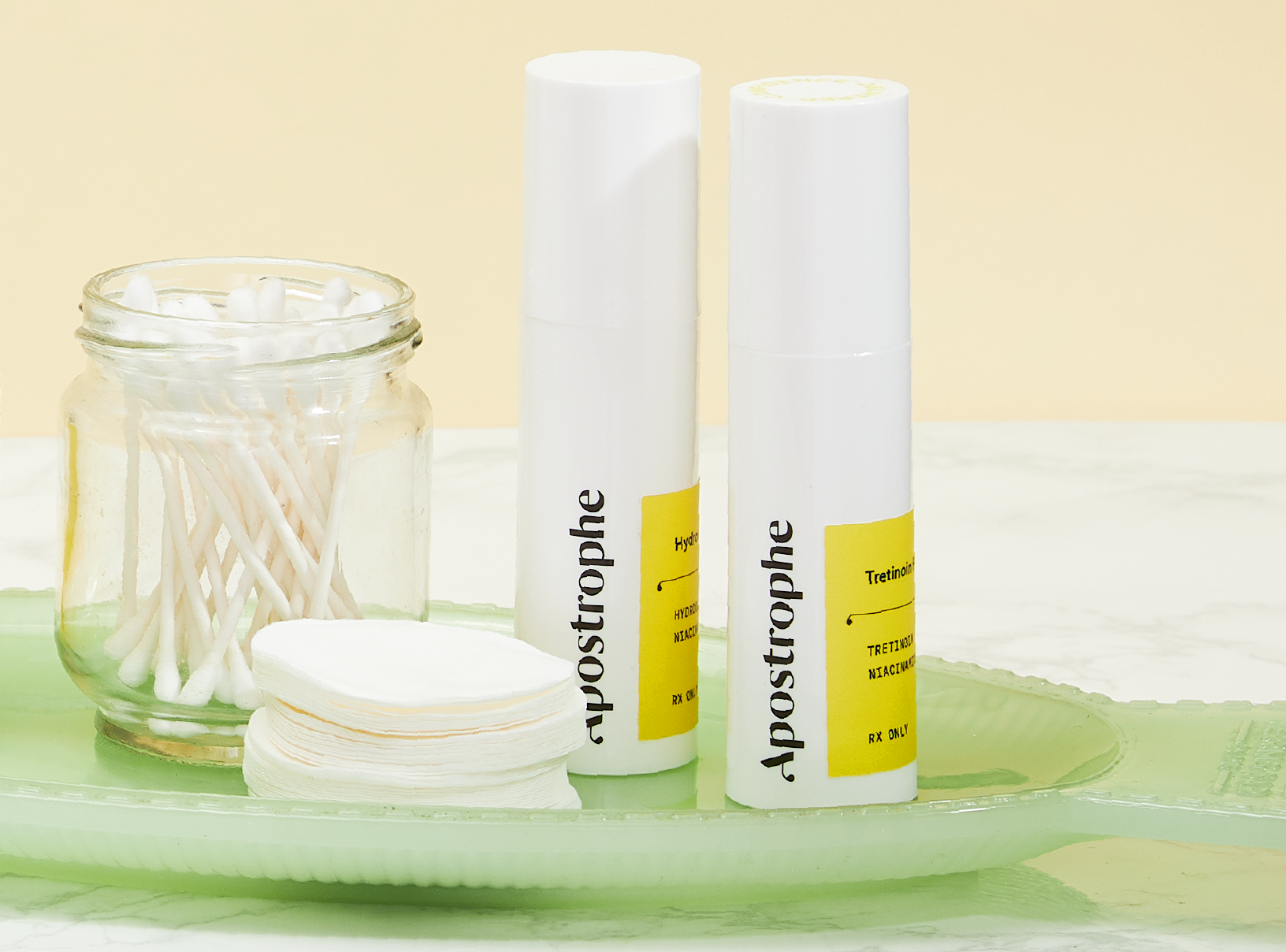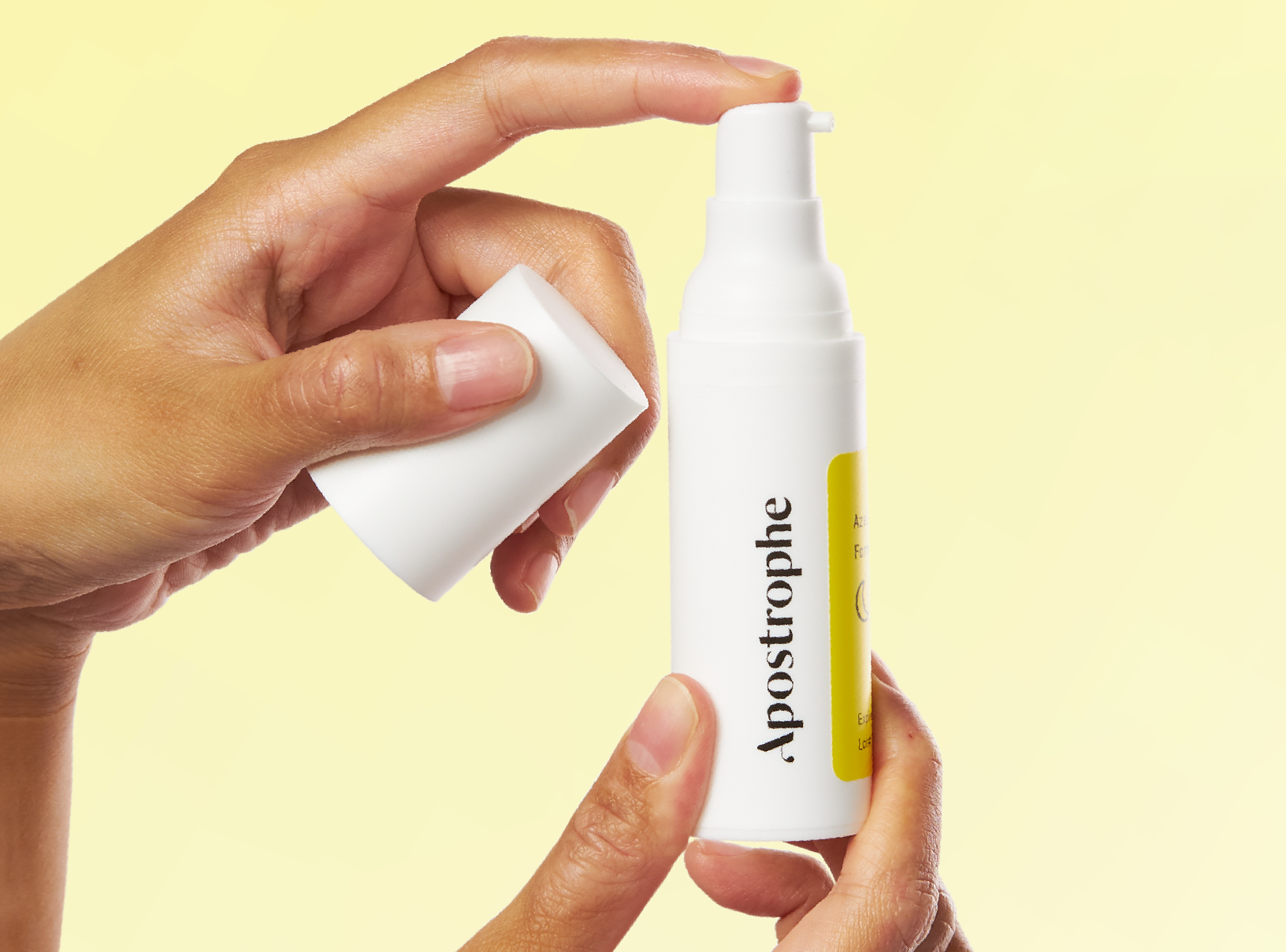Education
What SPF Should I Use? | Apostrophe


SHARE
Education
What SPF Should I Use? | Apostrophe
Medically reviewed by Aimee Paik, MD
Written by Apostrophe Team
Last updated 10/1/2024
What SPF Should You Use For Your Face?
If you treat SPF numbers a bit like roulette—15? 30? 50?—it might be time to change the game with a little expert advice.
That number on your bottle of sunscreen is important. It can make the difference between proper protection and putting yourself at risk for skin conditions caused by sun damage like burns, premature aging, and even cancer. Here’s your guide to learning what SPF you should use for your face.
How Does Sunscreen Work?
First things first, how does sunscreen work, and why do we even need it? In addition to its golden rays of visible light that make your days brighter and warmer, some of the sun’s rays are made up of UV rays. Because of these UV rays, the sun is the main source of UV radiation.
Ultraviolet light is made up of shorter wavelengths that are invisible to the human eye. These invisible wavelengths are actually a kind of radiation that can damage your DNA, which is why you need to wear sunscreen, follow sun safety tips, and always be sun-aware, regardless of your skin type. There are three types of ultraviolet light:
1. UVA (Ultraviolet A) – Out of all the UV radiation that penetrates the earth’s atmosphere, 95% is UVA. UVA radiation can infiltrate deeper into your skin than UVB light. As a result, these harmful UV rays can cause visible signs of aging, such as fine lines and premature wrinkles.
2. UVB (Ultraviolet B) – You may not be able to see UVB light, but you’re probably familiar with its results; this type of ultraviolet light causes a sunburn. It can also cause damage at the cellular level of your DNA. Our ozone layer absorbs most of this type of ultraviolet light, but we still need to protect ourselves from it.
3. UVC (Ultraviolet C) – UVC is the most damaging type of UV light, but you don’t need to worry about it because our atmosphere completely absorbs it before it ever reaches your skin.
Both UVA and UVB can cause skin cancer, in addition to sunburn and aging, which is why you need to take the question of “what SPF should I use?” seriously.
We couldn’t discuss sunscreen without mentioning our bodies’ built-in UV protection: melanin. Melanin is a natural pigment responsible for giving our hair and skin its natural pigmentation. Melanin also affects your sensitivity to ultraviolet light. That means that people with a darker skin tone have more natural sun shielding, but even the darkest skin tones only have an SPF of 13, well below the recommended SPF coverage required.In short, melanin provides a tiny bit of sun protection but it’s not enough on it’s own and you definitely shouldn’t rely on it to protect you from the damaging effects of the sun.
Translation: everyone needs sunscreen! Why? Sunscreen protects your skin from these ultraviolet rays.
You’ve probably been smearing sunscreen all over your body for your whole life, but you may not understand how it works, or you may be confused by sunscreen myths. It seems like there are so many different types of sunscreens to choose from when you visit the store, but there are really only two primary types of sunscreen:
Chemical Sunscreen – Chemical sunscreens are made out of organic filters that protect you from the sun by absorbing its ultraviolet rays and converting them into a longer, lower, and less damaging wavelength.
Mineral Sunscreen – Physical sunscreens are made out of mineral filters that protect you from the sun by absorbing, reflecting, or scattering its ultraviolet light.
Chemical sunscreens include ingredients such as:
Adimate O
Octinoxate
Octisalate
Octocrylene
Ensulizole
It’s important to choose sunscreens labeled as broad-spectrum because they protect you from UVA and UVB light. Ingredients that protect you from UVA light include:
Oxybenzone
Meradimate
Avobenzone
Terephthalylidene dicamphor sulfonic acid
Mineral sunscreens include ingredients such as:
Titanium dioxide
Zinc Oxide
Regardless of the type of sunscreen or sunscreen vehicle you choose, the product should list its SPF, which is its sun protection factor. What does that mean? SPF is a measure of UVB absorption, or how much UVB rays your sunscreen is protecting you from. The number tells you the time it would take the UVB radiation to redden your skin (when using the product precisely as directed) versus the time it would take to redden your skin without any sunscreen. So, for example, if you were wearing SPF 15, it would take you 15 times longer to burn than if you were in the sun with no sunscreen at all.
So let’s put that into SPF perspective. Let’s say it takes 15 minutes for your skin to burn in the sun. If you were wearing...
SPF 15, it would take you 225 minutes to get burned.
SPF 30, it would take you 450 minutes to get burned.
SPF 50, it would take you 750 minutes to get burned.
Different SPF numbers mean different levels of protection. The higher you go, the more protection you get—but that’s only with perfect use according to the directions, like applying the sunscreen 15 minutes before you’re out in the sun or reapplying every two hours.
“But what about UVA?” You must be asking. “I want to protect my skin from aging too!” Whereas UVB has SPF, UVA has UVA-PF—the UVA protective factor. Like SPF, the UVA-PF measures how effective the sunscreen is against protecting from UVA rays.
Our methods for measuring UVA protection are newer than our methods for measuring UVB protection. However, since the FDA requires that broad-spectrum sunscreens include proportional UVA and UVB protection, you can assume higher SPF sunscreens also have higher UVA protection.
What SPF Sunscreen Should I Use?
So now you understand why you need sunscreen and how it works, but you might still be wondering: “what SPF should I use on my face?”
The European Union divides SPF into four categories:
1. Low SPF – SPFs of 6 and 10 are considered low.
2. Medium SPF – SPFs of 15, 20, and 25 are considered medium.
3. High SPF – SPFs of 30 and 50 are considered high.
4. Very High SPF – SPFs of 50 and higher are considered very high.
The United States Food and Drug Administration (FDA) also regulates sunscreen SPF requirements. In particular, SPFs between 2 and 14 cannot claim that they reduce the risk of skin cancer or aging. Likewise, SPFs above 50 must add to their label that there is a lack of evidence to justify sunscreens over SPF 50.
So... what SPF should I use?
The American Academy of Dermatology recommends SPF 30 or higher.
Another consideration when choosing SPF might be your natural skin tone. Although people of color have more natural sunscreen in the form of melanin, dermatologists with the Skin of Color Society recommend that people of color still use at least SPF 15, broad-spectrum sunscreen to prevent all types of sun damage.
One final consideration for which SPF to choose: do you use any medications? Many different types of medications, both over-the-counter and prescription drugs, can increase sun sensitivity, such as:
Antibiotics
Antifungals
Antihistamines
Cholesterol-lowering drugs
Diuretics
Non-steroidal anti-inflammatory drugs
Oral contraceptives and estrogens
Phenothiazines such as tranquilizers and anti-emetics
Psoralens
Retinoids
Sulfonamides
Sulfonylureas for type 2 diabetes
You’ll notice that several of these medications can be taken for skin-related concerns such as acne or rosacea, including:
Alpha-hydroxy acids
Antibiotics
Oral contraceptives
Retinoids
The FDA recommends that if you experience photosensitivity or take any of these medications, you should choose a higher SPF of at least SPF 30. Sun exposure can also worsen the post-inflammatory hyperpigmentation caused by acne, which is yet another reason to wear SPF if you suffer from acne or take certain acne medications. If you're worried about sunscreen causing more acne, try searching for the best sunscreen for clogged pores.
It’s Not All About SPF: Other Ways to Protect Your Skin from Sun Damage
So that’s it: choose an SPF of at least 30. But is it? SPF is important, but it’s not the only factor when it comes to protecting your skin from sun damage and all its consequences, including sunburns, aging, and skin cancer. We’ve broken down a few more ways that you can protect your skin from the sun.
Sunscreen Tips
In addition to choosing the right SPF, follow these sunscreen tips to avoid skin damage:
Remember to choose sunscreen labeled as broad-spectrum so you’ll have protection from both UVA and UVB radiation.
Don’t forget to apply sunscreen to commonly missed areas such as the ears, neck, chest, and the back of your hands.
Use water-resistant sunscreen when swimming or sweating.
Apply the recommended amount of sunscreen, about ⅓ to ½ a teaspoon of sunscreen on the face, neck, and ears, or about two good layers on the skin.
Reapply your sunscreen every two hours, especially when outdoors. In one study, the SPF reduced 38 and 41 percent after four hours and 55 and 58 percent after eight hours.
Check the SPF of your products, especially cosmetics. SPF-containing foundations usually only have an SPF between 2 and 5.
Other Ways to Protect Your Skin
Besides sunscreen, here are a few more tips to protect your skin:
Stay in the shade, especially between 10 AM and 4 PM.
Protect your body from the sun with long-sleeved clothing and hats.
Be extra cautious around snow, water, and sand because they reflect the sun.
Get your Vitamin D through a healthy diet and supplements rather than relying on the sun.
Don’t use tanning beds.
Do yearly skin checks to scan for signs of skin cancer.

HYPERPIGMENTATION TREATMENT
Target dark spots and hyperpigmentation with customized prescription treatment.
Safeguard Your Skin with Apostrophe
With your newfound sunscreen knowledge, you’ll be able to make skincare purchases and protect your skin with confidence.
Nothing is more important than how you feel, and, often, your skin has a big role to play in that. Look your best and feel confident with Apostrophe. Get access to an expert dermatology team to help you develop your skincare routine, and we’ll deliver the custom skin care products right to your doorstep.
Sources:
NASA. Ultraviolet Waves. https://science.nasa.gov/ems/10_ultravioletwaves
Merk Manual. Overview of Sunlight and Skin Damage. https://www.merckmanuals.com/home/skin-disorders/sunlight-and-skin-damage/overview-of-sunlight-and-skin-damage
National Center for Biotechnology Information. Light, Including Ultraviolet. https://www.ncbi.nlm.nih.gov/pmc/articles/PMC2835849/
National Center for Biotechnology Information. Comprehensive Review of Ultraviolet Radiation and the Current Status on Sunscreens. https://www.ncbi.nlm.nih.gov/pmc/articles/PMC3460660/
Longdom Publishing. Melanin. https://www.longdom.org/peer-reviewed-journals/melanin-29218.html
National Center for Biotechnology Information. Comparison of UVA Protection Factor Measurement Protocols. https://www.ncbi.nlm.nih.gov/pmc/articles/PMC7244352/
Skin Cancer Foundation. Breaking Down Broad-Spectrum Protection: Why Your Sunscreen Needs to Have it. https://www.skincancer.org/blog/broad-spectrum-protection-sunscreen/
National Center for Biotechnology Information. Sunscreening Agents. https://www.ncbi.nlm.nih.gov/pmc/articles/PMC3543289/
American Academy of Dermatology Association. Sunscreen FAQs. https://www.aad.org/public/everyday-care/sun-protection/sunscreen-patients/sunscreen-faqs
Skin Cancer Foundation. All About Suncreen. https://www.skincancer.org/skin-cancer-prevention/sun-protection/sunscreen/
Skin of Color Society. Sun Protection for Skin of Color. https://skinofcolorsociety.org/dermatology-education/sun-protection-for-skin-of-color/
U.S. Food and Drug Administration. The Sun and Your Medicine. https://www.fda.gov/drugs/special-features/sun-and-your-medicine
National Center for Biotechnology Information. Clinical and Biological Characterization of Skin Pigmentation Diversity and Its Consequences on UV Impact. https://www.ncbi.nlm.nih.gov/pmc/articles/PMC6163216/
American Academy of Dermatology Association. Sunscreen FAQs. https://www.aad.org/public/everyday-care/sun-protection/sunscreen-patients/sunscreen-faqs
Plos One. Application of SPF moisturisers is inferior to sunscreens in coverage of facial and eyelid regions. https://journals.plos.org/plosone/article?id=10.1371/journal.pone.0212548
Like what you just read? Sign up for our email list to get the scoop on skincare science delivered straight to your inbox.

Deep Dives
A dermatologist shares his thoughts on the recent studies about benzoyl peroxide and benzene.
Read More
Education
What is milia?
What is milia? Today, we’re jumping into one type of bump that you may have heard about most commonly in infants — milia.
Read More
Education
Best moisturizer for acne-prone skin
If you have combination acne-prone skin, figuring out which moisturizer is best for your skin might be tough. In this guide, we break down the best moisturizer for combination, acne-prone skin.
Read More